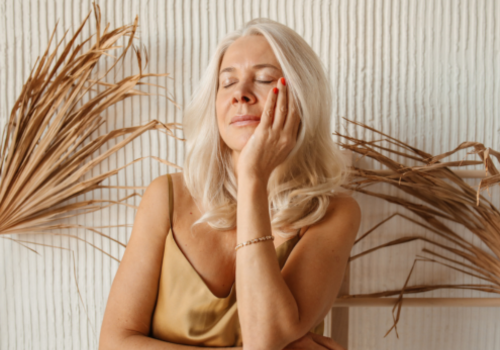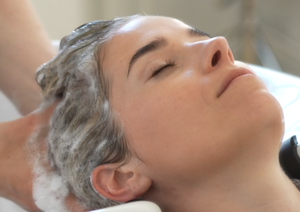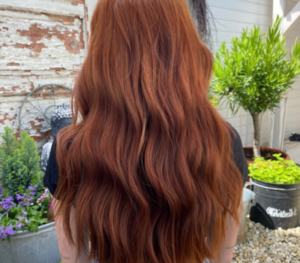If you've ever considered coloring your white hair, you're not alone. The process of coloring hair has become a common practice for those looking to conceal signs of aging or express their personal style. In this article, we'll explore in detail the different methods and techniques for effectively coloring white hair.
Preparing for natural hair coloring
Before you start coloring your hair naturally, it's essential to prepare it properly. Here are some important steps to follow to ensure you get the best results:
Perform a sensitivity test Before applying color all over your hair, perform a skin sensitivity test to check whether you have an allergic reaction to the product. Apply a small amount of colorant to your skin and wait 24 hours to observe any adverse reaction.
Protect your skin Apply a greasy cream or Vaseline along your forehead, ears and neck to prevent the color from staining your skin. This will help you achieve a clean, professional application.
Divide your hair into sections Divide your hair into several sections using clips or bobby pins to make color application easier. This will also ensure that each strand is evenly covered.
Wear gloves Before applying hair color, put on plastic gloves to protect your hands from any unwanted staining. Be sure to wear them throughout the application process.
Choosing the right shade to camouflage my graying hair
When you decide to color your hair to camouflage white hair, it's essential to choose the right shade to achieve a natural, harmonious result. Here are a few tips to help you select the perfect hair color based on the density of your white hair:
Assessing the proportion of white hair Start by assessing the density and distribution of your white hair. If you only have a few white strands, you can opt for a shade close to your natural color to camouflage them discreetly. On the other hand, if you have a higher proportion of white hair, you may need to choose a slightly darker color for better coverage.
Consider the base color The basic color of your hair plays a crucial role in your choice of coloring tint. If you have dark hair, you may want to choose a shade closer to your natural color to avoid too strong a contrast with white hair. On the other hand, if you have light hair, you can experiment with brighter, more vibrant shades.
Take skin tone into account Your skin tone can also influence your choice of color shade. Fair-skinned people may opt for warm shades like golden blonds or coppers to brighten up their complexion. On the other hand, darker-skinned people may prefer richer, deeper shades like chocolate browns or ebony blacks.
Pre-testing Before committing yourself to permanent hair color, we recommend that you first try out a semi-permanent color or a test strand. This will enable you to visualize the final result and ensure that the chosen shade matches your expectations.

Semi-permanent vegetable colorations: A natural alternative for your hair
Natural ingredients Botanical colorants are formulated with plant extracts such as henna, indigo, chamomile and hibiscus, which are renowned for their coloring properties. These natural ingredients allow hair to be colored while providing additional benefits, such as shine and softness.
Semi-permanent hair color Unlike permanent colorants, which penetrate the hair cuticle to permanently alter color, semi-permanent vegetable colorants simply deposit a layer of pigment on the hair surface. This means the color gradually fades with each shampoo, for a more subtle, natural result.
Wide range of colors Botanical colorants are available in a wide range of shades, from golden blondes to rich browns and blacks. You can also mix different plant extracts to create customized, unique shades that match your preferences and style.
Hair benefits As well as coloring hair, vegetable colorants also offer health benefits. The plant extracts used in these colorants are rich in nutrients and antioxidants, which nourish and strengthen hair, while protecting it from damage caused by external aggressors.
Easy to use Plant dyes are easy to use at home and require no complex mixing or prolonged development. Simply mix plant powder with warm water to form a paste, then apply evenly to hair. After a recommended application time, rinse thoroughly to reveal radiant, natural color.
Natural permanent hair color : A long-lasting solution for radiant hair
Natural permanent hair colors offer a sustainable, eco-friendly alternative for those seeking long-lasting hair color without compromising their health. Unlike traditional colorants, which often contain harsh chemicals, natural permanent colorants are made from natural ingredients and plant extracts, offering a gentler, safer solution for coloring your hair. Here's what you need to know about natural permanent hair color:
Formulated with natural ingredients Natural permanent hair colors are formulated with plant extracts and natural ingredients such as henna, indigo and chamomile. These ingredients are rich in natural pigments to color hair effectively, while providing additional benefits such as shine and softness.
White hair coverage Unlike semi-permanent colorations, which simply deposit a layer of pigment on the hair's surface, natural permanent colorations penetrate the cuticle to permanently modify hair color. This means they offer optimum coverage of white hair, even for the most resistant hair.
Lasting results Natural permanent colorations offer long-lasting results that stand the test of time and repeated washing. Unlike traditional colorants, which can fade quickly, natural permanent colorants offer vibrant color that stays vibrant for weeks, even months, after application.
Nourishes and strengthens hair As well as coloring hair, natural permanent hair colors also offer health benefits. The natural ingredients used in these colorants are rich in nutrients and antioxidants, which nourish and strengthen hair from within, leaving it soft, strong and radiantly healthy.
Easy to use Natural permanent hair colors are easy to use at home and require no complex mixing or prolonged development. Simply follow the instructions supplied with the product for professional results with every application.
I use shampoos specially formulated for color-treated hair
When you opt for hair coloring, it's essential to adopt the right care routine to preserve the color and health of your hair. Using shampoos specially formulated for color-treated hair can make all the difference in prolonging the durability of your color and maintaining the health of your hair. Here's why it's important to use shampoos specially formulated for color-treated hair:
Preserves color Shampoos specially designed for color-treated hair are formulated with gentle agents that preserve color by preventing premature washout. They help maintain the radiance and shine of your color, allowing you to enjoy long-lasting, vibrant results.
Nourishes hair These shampoos are enriched with moisturizing and nourishing ingredients that help restore hair moisture and keep it soft and silky. They also help strengthen hair weakened by coloring, leaving it strong and resistant to damage.
Protects against external aggression Shampoos for color-treated hair often contain UV filters and protective agents that shield hair from damage caused by the sun's rays, pollution and other external aggressors. This helps preserve your hair's color and shine, even after prolonged exposure to the elements.
Prevents discoloration By gently removing impurities and hair product residues, shampoos suitable for coloring help prevent color fading and discoloration. They leave hair clean and fresh, ready for styling without compromising color.
Suitable for all hair types Whether you have dry, normal, oily or fine hair, there are shampoos adapted to coloring to meet the specific needs of each hair type. You can choose the one that best suits your hair type and hair concerns for optimal results.





